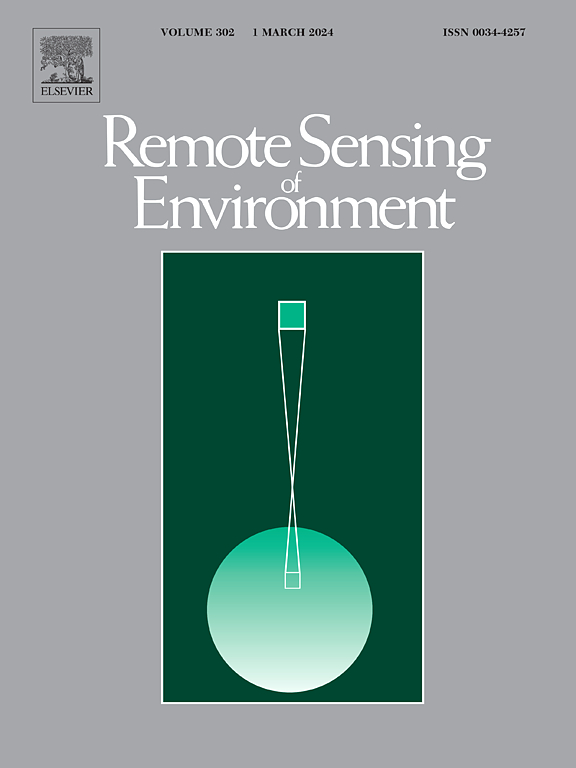Spatio-Temporal reconstruction to fill spatial gaps in global satellite vegetation optical depth products
IF 11.4
1区 地球科学
Q1 ENVIRONMENTAL SCIENCES
引用次数: 0
Abstract
Vegetation Optical Depth (VOD) serves as a crucial tool for monitoring vegetation characteristics and plays a vital role in terrestrial ecosystems. The vegetation optical depth dataset from AMSR-E/2 using multi-channel collaborative algorithm (MCCA-AMSR VOD) possesses a longer time series spanning from 2002 to 2022. However, due to the limitations of satellite orbital scanning gap and retrieval algorithms, existing VOD datasets do not achieve complete coverage in global land. To address the need for a VOD dataset with high spatio-temporal coverage across different bands, we reconstruct the MCCA-AMSR VOD dataset using the 3D partial convolutional neural network. Three evaluation methods are employed to further assessthe reconstructed VOD dataset. The reconstructed VOD achieves a higher average spatial coverage (95.01 %) compared with the original dataset (72.55 %). The correlation coefficients (R) between original and reconstructed VOD dataset for all five simulated missing regions exceeded 0.99, indicating that the reconstructed VOD has a very high correlation with the original dataset at the regional scale. Furthermore, comparison with optical vegetation indices indicates that the reconstructed VOD can also capture vegetation water contentwell. Therefore, reconstructed VOD can provide valuable support for research on drought and vegetation monitoring.
填补全球卫星植被光学深度产品空间空白的时空重构
植被光深(VOD)是监测植被特征的重要工具,在陆地生态系统中起着至关重要的作用。采用多通道协同算法(MCCA-AMSR VOD)的AMSR-E/2植被光学深度数据具有较长的时间序列,时间跨度为2002 - 2022年。然而,由于卫星轨道扫描间隙和检索算法的限制,现有的视频点播数据集无法实现全球陆地的完全覆盖。为了满足对不同波段高时空覆盖的视频点播数据集的需求,我们利用三维部分卷积神经网络重构了MCCA-AMSR视频点播数据集。采用三种评价方法对重建的视频点播数据集进行进一步评价。重建后的视频点播平均空间覆盖率(95.01%)高于原始数据集(72.55%)。5个模拟缺失区域的原始VOD数据与重建VOD数据的相关系数(R)均超过0.99,表明重建VOD数据在区域尺度上与原始VOD数据具有非常高的相关性。此外,与光学植被指数的对比表明,重建的VOD也能很好地捕捉植被含水量。因此,重建的视频点播可以为干旱和植被监测研究提供有价值的支持。
本文章由计算机程序翻译,如有差异,请以英文原文为准。
求助全文
约1分钟内获得全文
求助全文
来源期刊

Remote Sensing of Environment
环境科学-成像科学与照相技术
CiteScore
25.10
自引率
8.90%
发文量
455
审稿时长
53 days
期刊介绍:
Remote Sensing of Environment (RSE) serves the Earth observation community by disseminating results on the theory, science, applications, and technology that contribute to advancing the field of remote sensing. With a thoroughly interdisciplinary approach, RSE encompasses terrestrial, oceanic, and atmospheric sensing.
The journal emphasizes biophysical and quantitative approaches to remote sensing at local to global scales, covering a diverse range of applications and techniques.
RSE serves as a vital platform for the exchange of knowledge and advancements in the dynamic field of remote sensing.
 求助内容:
求助内容: 应助结果提醒方式:
应助结果提醒方式:


